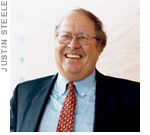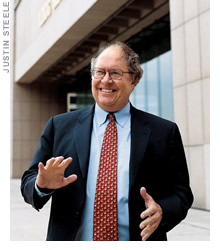A Legend Sizes Up the Market
Legg Mason's Bill Miller has faith in MannKind and sings the praises of a stock everyone loves to hate.

Like fellow Baltimorean Cal Ripken, Bill Miller will forever be defined by the streak. Miller's streak -- beating the return of Standard & Poor's 500-stock index for 15 straight years -- ended with a thud in 2006. His Legg Mason Value Trust trailed the index by ten percentage points. His newer, more-flexible fund, Legg Mason Opportunity Trust, a member of the Kiplinger 25, also lagged, but by only two percentage points.
So is Miller, at age 57, past his prime? Did the pressure of continuing his remarkable run drain him of the zeal to deliver the kind of returns that made him the most famous mutual fund manager on the planet?

Hardly. The streak was overblown to start with. It was partly an accident of the January-through-December calendar year -- Legg Mason trailed the market during a number of other 12-month periods. Still, Miller remains one of the sharpest, most innovative thinkers in the investing game, as we were reminded during a recent interview at Legg Mason's headquarters, next to Baltimore's striking Inner Harbor.
From just $107.88 $24.99 for Kiplinger Personal Finance
Become a smarter, better informed investor. Subscribe from just $107.88 $24.99, plus get up to 4 Special Issues

Sign up for Kiplinger’s Free Newsletters
Profit and prosper with the best of expert advice on investing, taxes, retirement, personal finance and more - straight to your e-mail.
Profit and prosper with the best of expert advice - straight to your e-mail.
Miller is particularly impressive when he argues about the foibles of most value investors and defends his own approach. In the late 1990s, he was criticized for being a value investor in name only because he owned shares of AOL, Dell and Amazon.com. Today, his big stake in Google once again leads some to question his credentials as a bargain hunter. But Miller turns the tables on his critics.
KIPLINGER'S: How does it feel now that you no longer have to defend your streak?
MILLER: Unfortunately, I still have to bear the burden of competing against the S&P 500. I just have to bear it now without the advantage of the streak.
You've said that you like to take advantage of errors that others make. What are today's big errors? At the broadest level, the big error is in how mega-cap stocks in the U.S. are being valued. I'm talking about companies like General Electric, Microsoft, AIG.
You're not the only one saying this. What will it take to get the mega caps to move? Time. My guess is that they will move this year because they've been cheap for several years, and they haven't done anything in all that time. I expect the economy to slow this year, and historically, that kind of environment has been good for mega caps. In a slowing economy, they're perceived to be safer. And they are safer. The top 50 names in the S&P 500 have lower price-earnings ratios, higher dividend yields, higher returns on equity and capital, better balance sheets, and more-balanced earnings than the bottom 450 names.
Do you make portfolio decisions based on this big-picture analysis? No. We don't have a forecast-and-trend approach -- meaning we don't make a forecast of what we think is likely to happen, or what trends are likely to occur, and then adjust our portfolio to conform to the forecasts. We estimate the intrinsic value of our companies and invest where we can get the greatest discount to intrinsic value. Then we try to understand the environment we're operating in. But we start with valuation -- that's always number one. We're saying that large-cap stocks are cheap historically. Then the questions are: Why are they cheap? What does the environment look like? What's happened in the past? What's caused things to change? We invest where we think we can get the best risk-adjusted rate of return. So we're adding to GE and AIG in Value Trust, establishing a position in GM, and cutting back on stocks with smaller market caps. Opportunity is different because its mandate is so broad.
You'll consider stocks that most value investors won't touch. How do you justify owning a Google? This is what I call the value conundrum. Look at what have been the biggest wealth-creating companies: Microsoft, Wal-Mart, GE, Johnson & Johnson. You could have bought Microsoft in 1991 at 35 times earnings and made 40 times your money over the next ten years. If you had bought Wal-Mart when it went public, you would have paid 20 times earnings and you would have made 10,000%. If a stock goes up 30 or 40 times in ten years, it has to have been grossly underpriced to begin with. So Microsoft was not expensive at 35 times earnings. It was one of the best bargains out there.
In retrospect. Yes, in retrospect. So was Cisco Systems. So were a lot of companies. What are value investors supposed to do? They're supposed to be able to find the bargains. The conundrum is, why do the greatest value-creating companies almost never find their way into value investors' portfolios? And the answer is that value investors won't look at those companies when they're actual bargains because it's hard to tell the difference between them and companies that are valued similarly that aren't going to do that well. So value investors have systematically ignored companies that could have made them huge amounts of money over time because the companies looked expensive on the surface, even though they weren't.
[page break]
Getting back to Google, what is its P/E? The consensus earnings estimate for 2007 is nearly $15, so the P/E is in the low 30s.
But you think its growth potential and its future cash flow make it cheap today? Yes. It trades at 24 times next year's earnings estimates. We can't find any other company in the market with a faster revenue growth rate and higher profit margins, and that dominates its business like Google but has a lower P/E multiple. MasterCard now has a higher 2008 P/E than Google!
It's that unique? Google trades at a lower multiple than Starbucks. Now, Starbucks is a great company, but Starbucks is growing at half Google's rate. On next year's estimated earnings, Google's P/E is six points higher than Coca-Cola's, but Coke long term is only an 8% grower.
At the other extreme, you have a huge stake in Eastman Kodak. That seems to be a value trap. It has been.
Why do you have faith in it? We don't have faith; we have beliefs based on evidence. Kodak has been a value trap because the time required to make the transition from where it was to where it will be at the end of this year was a lot longer than we thought it would be. And we underestimated the cultural change that was required of the company. It had a 100-year history of dominating a super-profitable business with almost no technological change. When Antonio Perez became CEO a couple of years ago, he pointed out that there's a certain mind-set that goes with that: complacency, and a tendency to move slowly because decisions don't have to be made quickly.
Is your case based on Kodak's entry into the inkjet-printer business? The new printer business is part of the thesis, which is that Kodak has introduced a technology that has the potential to disrupt the entire industry because it will be able to charge a lot less for ink cartridges -- about half the current price.
What's the rest of the thesis? It's simple. Throughout this entire transition, during which sales from film have dropped by almost two-thirds, Kodak has continued to generate about $1 billion in free cash flow before restructuring charges. That's because as film sales have dropped, its graphic-communications and digital businesses have improved. Investors today are valuing $1 billion of free cash flow at $14 billion to $15 billion in the marketplace. But Kodak's market value is just $6 billion. Why is it so low? Because for each of the past four or five years, Kodak had cash restructuring costs -- for environmental-cleanup liabilities, for the costs of closing plants, for severance when there were layoffs -- that have totaled roughly $600 million to $700 million per year at the peak. There will be $500 million to $600 million in additional restructuring charges this year related to closing film plants and the sale of Kodak's health-care business. Next year, there will be no restructuring charges. Unless the business gets a lot worse in the next year or so, Kodak will do $1 billion to $1.2 billion of free cash flow in 2008. And if that happens, the stock should be up 50% to 100% in that period of time.
How much of Kodak do you own? Legg Mason owns 24%. We and three other firms own half the company.

Which stock in Opportunity has the greatest potential? Over the next three years, MannKind. It is a biotechnology company started by a guy named Al Mann. Mann is eightysomething years old and is worth a couple of billion dollars. He's made all of his money starting and selling medical companies of one sort or another. One of my analysts came to me a year ago and said there's a little biotech company and there's insider buying of its shares by the CEO. I said, "That can't be right because there's never any insider buying at biotech companies, only insider selling." I looked, and sure enough, the CEO was buying stock. MannKind is developing an inhalable version of insulin for diabetes, which is a rapidly growing disease of affluence. The drug is now in stage-III trials. Pfizer already has a product out called Exubera, but it looks like a mini saxophone. The MannKind product looks like a little asthma inhaler. You pop it out, take a hit and put it back in your pocket. So far, there are no side effects whatsoever. If it in fact goes through these trials and wins approval, it could be as big as Lipitor, which is a $13-billion-a-year drug. That's worth $50 billion or $60 billion in market capitalization, and MannKind's market cap is just $1.5 billion. So that's a pretty good risk-reward situation.
Is it true you require members of your team to participate in a book club? Yes.
What's the theory behind this requirement? There are important things that we, as investors, need to understand. And it's valuable to have everyone on the same page by reading the same book, then have authors come in and talk about their ideas. For example, we've had Peter Bernstein, who wrote Against the Gods: The Remarkable Story of Risk, come in and talk about notions of risk and return.
What are you reading now? A book by Katrina Firlik called Another Day in the Frontal Lobe: A Brain Surgeon Exposes Life on the Inside. It's basically an inside look at what it's like to be a neurosurgeon and a little bit about the brain. Upcoming books are The Halo Effect, by Phil Rosenzweig, and The Difference, by University of Michigan professor Scott Page. It's about diversity theory.
Profit and prosper with the best of Kiplinger's advice on investing, taxes, retirement, personal finance and much more. Delivered daily. Enter your email in the box and click Sign Me Up.

-
 The Santa Claus Rally Officially Begins: Stock Market Today
The Santa Claus Rally Officially Begins: Stock Market TodayThe Santa Claus Rally is officially on as of Wednesday's closing bell, and initial returns are positive.
-
 How to Leave Different Amounts to Adult Children Without Causing a Rift
How to Leave Different Amounts to Adult Children Without Causing a RiftHere’s how to leave different amounts to adult children without causing a family rift.
-
 My Retirement Learning Curve, 1 Year In
My Retirement Learning Curve, 1 Year InA retiree checks in with what they wish they knew early on and what they've changed about their plan one year in.
-
 Best Banks for High-Net-Worth Clients
Best Banks for High-Net-Worth Clientswealth management These banks welcome customers who keep high balances in deposit and investment accounts, showering them with fee breaks and access to financial-planning services.
-
 Stock Market Holidays in 2025 and 2026: NYSE, NASDAQ and Wall Street Holidays
Stock Market Holidays in 2025 and 2026: NYSE, NASDAQ and Wall Street HolidaysMarkets When are the stock market holidays? Here, we look at which days the NYSE, Nasdaq and bond markets are off in 2025 and 2026.
-
 Stock Market Trading Hours: What Time Is the Stock Market Open Today?
Stock Market Trading Hours: What Time Is the Stock Market Open Today?Markets When does the market open? While the stock market has regular hours, trading doesn't necessarily stop when the major exchanges close.
-
 Bogleheads Stay the Course
Bogleheads Stay the CourseBears and market volatility don’t scare these die-hard Vanguard investors.
-
 The Current I-Bond Rate Is Mildly Attractive. Here's Why.
The Current I-Bond Rate Is Mildly Attractive. Here's Why.Investing for Income The current I-bond rate is active until April 2026 and presents an attractive value, if not as attractive as in the recent past.
-
 What Are I-Bonds? Inflation Made Them Popular. What Now?
What Are I-Bonds? Inflation Made Them Popular. What Now?savings bonds Inflation has made Series I savings bonds, known as I-bonds, enormously popular with risk-averse investors. How do they work?
-
 This New Sustainable ETF’s Pitch? Give Back Profits.
This New Sustainable ETF’s Pitch? Give Back Profits.investing Newday’s ETF partners with UNICEF and other groups.
-
 As the Market Falls, New Retirees Need a Plan
As the Market Falls, New Retirees Need a Planretirement If you’re in the early stages of your retirement, you’re likely in a rough spot watching your portfolio shrink. We have some strategies to make the best of things.